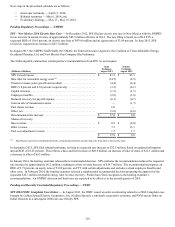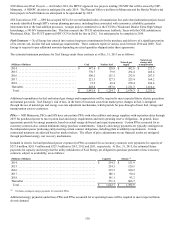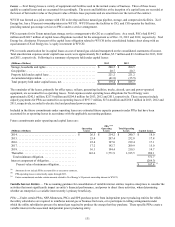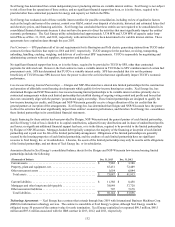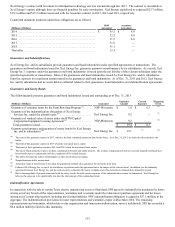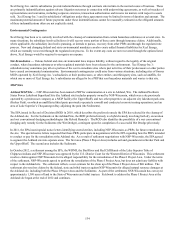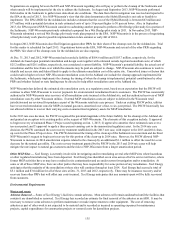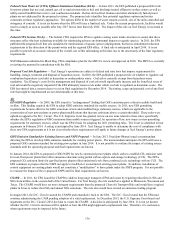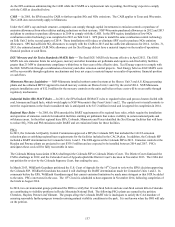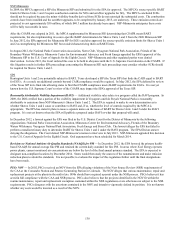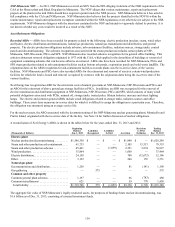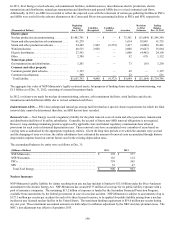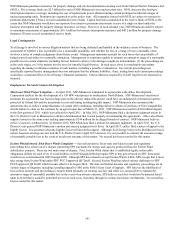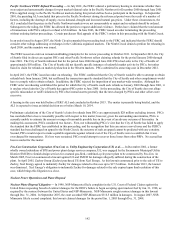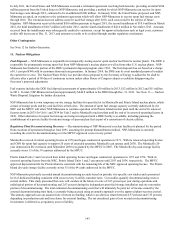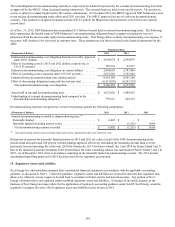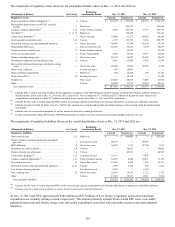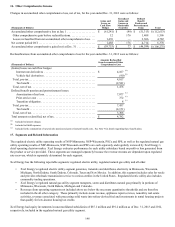Xcel Energy 2013 Annual Report Download - page 154
Download and view the complete annual report
Please find page 154 of the 2013 Xcel Energy annual report below. You can navigate through the pages in the report by either clicking on the pages listed below, or by using the keyword search tool below to find specific information within the annual report.
136
Federal Clean Water Act (CWA) Effluent Limitations Guidelines (ELG) — In June 2013, the EPA published a proposed ELG rule
for power plants that use coal, natural gas, oil or nuclear materials as fuel and discharge treated effluent to surface waters as well as
utility-owned landfills that receive coal combustion residuals. Refuse derived fuel, biomass and other alternatively fueled power
plants are not addressed by the proposed revisions. The proposed rule identifies four potential regulatory options and invites
comments on those regulatory approaches. The options differ in the number of waste streams covered, size of the units controlled and
stringency of controls. It is not yet known when the EPA will issue a finalized rule. Under the current proposed rule, facilities would
need to comply as soon as possible after July 2017 but no later than July 2022. The impact of this rule on Xcel Energy is uncertain at
this time.
Federal CWA Section 316 (b) — The federal CWA requires the EPA to regulate cooling water intake structures to assure that these
structures reflect the best technology available for minimizing adverse environmental impacts to aquatic species. In 2011, the EPA
published the proposed rule that sets standards for minimization of aquatic species impingement, but leaves entrainment reduction
requirements at the discretion of the permit writer and the regional EPA office. A final rule is anticipated in April 2014. It is not
possible to provide an accurate estimate of the overall cost of this rulemaking at this time due to the uncertainty of the final regulatory
requirements.
NSP-Minnesota submitted its Black Dog CWA compliance plan for the MPCA’s review and approval in 2010. The MPCA is currently
reviewing the proposal in consultation with the EPA.
Proposed Coal Ash Regulation — Xcel Energy’s operations are subject to federal and state laws that impose requirements for
handling, storage, treatment and disposal of hazardous waste. In 2010, the EPA published a proposed rule on whether to regulate coal
combustion byproducts (coal ash) as hazardous or nonhazardous waste. Coal ash is currently exempt from hazardous waste
regulation. Xcel Energy’s costs for the management and disposal of coal ash would significantly increase and the beneficial reuse of
coal ash would be negatively impacted if the EPA ultimately issues a rule under which coal ash is regulated as hazardous waste. The
EPA has entered into a consent decree to act on final regulations by December 2014. The timing, scope and potential cost of any final
rule that might be implemented are not determinable at this time.
Air
EPA GHG Regulation — In 2009, the EPA issued its “endangerment” finding that GHG emissions pose a threat to public health and
welfare. This finding required the EPA to adopt GHG emission standards for mobile sources. In 2011, new EPA permitting
requirements became effective for GHG emissions of new and modified large stationary sources, which are applicable to the
construction of new power plants or power plant modifications that increase emissions above a certain threshold. These rules were
upheld on appeal to the D.C. Circuit. The U.S. Supreme Court has granted review on one issue related to these rules, specifically
whether the EPA’s regulation of GHG emissions from mobile sources triggered, by operation of law, new source review permitting
requirements for stationary sources, which was the EPA’s basis for adopting the 2011 permitting rules. The Court is scheduled to hear
arguments in February 2014. A ruling is anticipated by June 2014. Xcel Energy is unable to determine the cost of compliance with
these new EPA requirements as it is not clear whether these requirements will apply to future changes at Xcel Energy’s power plants.
GHG Emission Standard for Existing Sources and NSPS Proposal — In June 2013, President Obama issued a memorandum
directing the EPA to develop GHG emission standards for existing power plants. The memorandum anticipates the EPA will issue a
proposed GHG emission standard for existing power plants in June 2014. It is not possible to evaluate the impact of existing source
standards until the upcoming proposal and final requirements are known.
In January 2014, the EPA re-proposed a GHG NSPS for newly constructed power plants which seeks to establish CO2 emission rates
for coal-fired power plants that reflect emission reductions using partial carbon capture and storage technology (CCS). The EPA’s
proposed CO2 emission limits for gas-fired power plants reflect emissions levels from combined cycle technology with no CCS. The
EPA continues to propose that the NSPS not apply to modified or reconstructed existing power plants. In addition, installation of
control equipment on existing plants would not constitute a “modification” to those plants under the NSPS program. It is not possible
to evaluate the impact of the re-proposed NSPS until its final requirements are known.
CSAPR — In 2011, the EPA issued the CSAPR to address long range transport of PM and ozone by requiring reductions in SO2 and
NOx from utilities in the eastern half of the United States. For Xcel Energy, the rule would have applied in Minnesota, Wisconsin and
Texas. The CSAPR would have set more stringent requirements than the proposed Clean Air Transport Rule and would have required
plants in Texas to reduce their SO2 and annual NOx emissions. The rule also would have created an emissions trading program.
In August 2012, the D.C. Circuit vacated the CSAPR and remanded it back to the EPA. The D.C. Circuit stated that the EPA must
continue administering the CAIR pending adoption of a valid replacement. In December 2013, the U.S. Supreme Court heard oral
arguments on the D.C. Circuit’s 2012 decision to vacate the CSAPR. A decision is anticipated by June 2014. It is not yet known
whether the D.C. Circuit’s decision will be upheld, or how the EPA might approach a replacement rule. Therefore, it is not known
what requirements may be imposed in the future.




